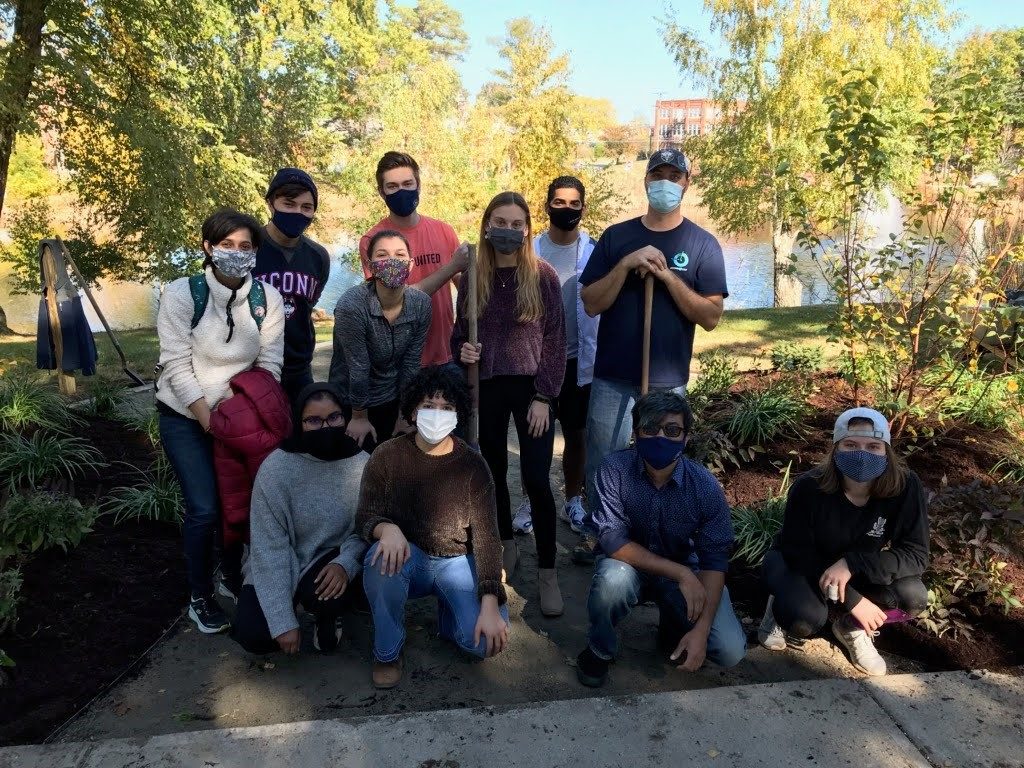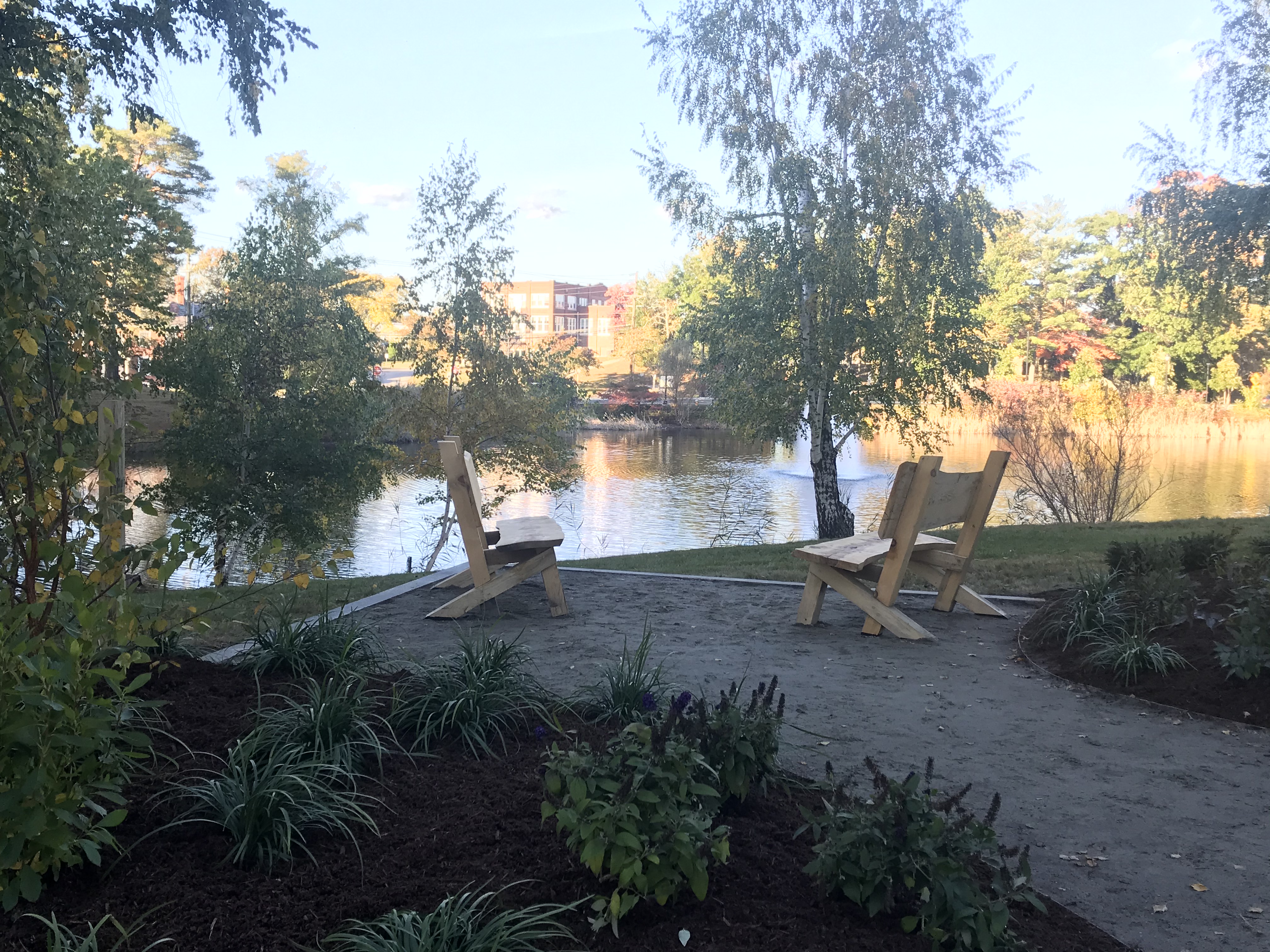The memory of an old friend and a peaceful place to sit and connect are the twin inspirations for a small new garden planted Wednesday, Oct. 14 alongside Swan Lake.
The garden brings together two separate student-led initiatives that share common goals – one aimed at preserving the legacy of the “swing tree” and the other for UConn-made “buddy benches” built to foster human connection. The similarities between the two efforts captured the attention of Sean Vasington, Director of Site Planning and Landscape Architecture for University Planning, Design, and Construction. In his role as University Landscape Architect and member of UConn’s Arboretum Committee, he was very familiar with the “swing tree” story and became aware of the “buddy bench” efforts when he was asked to find a home for them somewhere on campus.
“As we contemplated the two initiatives with the provost’s office and others, it occurred to me that they each spoke to the well-being of our students and could be more meaningful and memorable if paired. Everyone agreed, so we created a very modest plan for a small seating area overlooking Swan Lake with the two benches encompassed by plant beds for two ‘swing tree’ saplings and other plantings,” says Vasington.
“This space could not have happened without faculty interest and student involvement, support from Student Health and Wellness, a financial contribution from the Office of Sustainability, and various resources from Facilities Operations in implementing the plan. During an otherwise extraordinary time in our campus’s history, it was a great pleasure to be a part of this effort,” he adds.
“This project brings a lot of different people together,” says Emma MacDonald ’21 (CAHNR), an intern in the Office of Sustainability, and member of the Arboretum Committee who has been part of the garden planning process. “I’m excited for it mostly because it seems like it will be a great place for people to really connect. I’m really excited about the swing trees – I know a lot of students have an emotional connection and really miss that big tree next to Mirror Lake. I know I do.”
At the time the swing tree was serving as a place to reflect, a movement to help combat loneliness and foster connections was underway, driven by a worldwide, student-led initiative to build “buddy benches” to support classmates in need. Phoebe Godfrey, Associate Professor in Residence of Sociology, says her fall 2019 Society and Climate Change course decided to build some benches as part of the service learning component of the class.
“In the past, I have had the students pick small projects and a lot of the projects have focused on the UConn community,” says Godfrey. “The way I teach is to build community, because I do not think it is very effective to teach about climate change or structural racism or patriarchy in a hierarchical way. In class, it came up that there weren’t enough dialogues about climate change and there weren’t enough spaces to talk about it in intelligent and thoughtful ways.”
The buddy benches differ from other benches on campus in that the seats face one another, and Godfrey explains the buddy benches are a space to have a dialogue, whether about climate change or other difficult topics.
“The more connected we are, the more conscious we are about what is going on around us,” Godfrey says. “We need a place. From a sociological perspective, I see all things to do with humans as socially constructed, and so, by collectively focusing on a given idea, it can become both socially and even physically real. So if you say these are benches designed to talk about climate change, or racism, or difficult dialogues, and if you designate it, it makes people question and think about the topics.”
Godfrey’s students constructed the benches with help from Herb Virgo of the Keney Park Sustainability Project, who had made similar benches for Keney Park. The wood used to construct the “buddy benches” was sustainably harvested from the UConn Forest, making the project not only UConn-made, but also UConn-grown.

The next step was to decide where they would be placed. Thomas Jacobson ’20 (CLAS) had the idea of creating a garden to house the buddy benches and helped get the project started through a service learning project for Godfrey’s class.
Godfrey connected with Vasington, who convened a committee including faculty, staff, and students to develop a plan. Several locations were considered, but the committee eventually decided a location next to Swan Lake made the most sense.
Patrick McKee, Sustainability Program Manager in the UConn Office of Sustainability and member of the Arboretum Committee, points out that this project unites multiple stories and efforts: “UConn has a commitment to planting new trees, we are an Arbor Day Foundation Tree Campus USA campus, the project also has a health and wellness aspect to it, and of course it aligns with UConn’s general commitment to enhancing outdoor spaces for students.”
Wesley Ayers III, Grounds and Landscaping Manager and member of the Arboretum Committee, says he is excited to have students involved in creating the garden.
“We don’t have enough spaces like this around campus,” he says. “I’m excited to see the descendants of the ‘swing tree’ get used for what it was originally intended for — as a place for students to come and talk. Now there are benches to facilitate maybe deeper discussions. Next to Swan Lake, it’s a peaceful place to come and relax.”
“As a project born out of a Service Learning course, the garden is an important example of when time and space are given to students to critically reflect about how course content and current day social dilemmas align, students have the power to create an action out of those discussions,” says Julia Yakovich, University Director of Service Learning Initiatives in the Center for Excellence in Teaching and Learning. “This is the product of those meaningful discussions. Professor Godfrey created an opportunity through Service Learning to connect students, community partners and upper-level administration with a common goal in mind, and the result is a successful project.”
Now that the project is complete and the garden is in place, MacDonald hopes the campus community will seek it out and spend some time there.
“I hope this serves as a general call for people to come and enjoy the experience, to write in the journal, and know where it is located. The hardest thing for us (at the Office of Sustainability) is getting people to know about the projects we are doing. Go check it out, go have fun, see the garden, and enjoy it,” she says.



